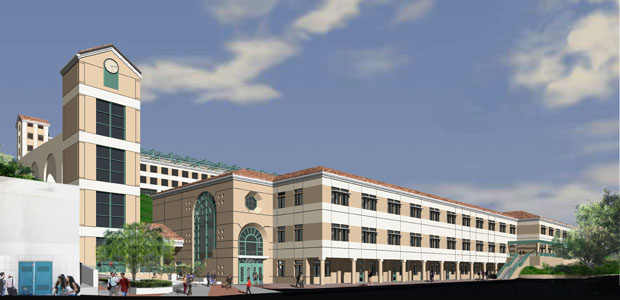Construction for the new Lab/College Services Building has begun but the official groundbreaking ceremony will be held on Oct. 21 at 4 p.m. at the construction site below the parking structure.
The plan for the building was originally developed in 2004 under President John Davitt, who retired in 2008. According to Jim Spencer, campus architect for 20 years, the project was conceived from a 2002 master plan to update the school’s population capacity. In 2003, planning began for a one-stop center, the creation of more classrooms and the replacement of the temporary classrooms.
“Gradually, we realized that there’s only so much land — so we decided to merge the two [projects] together,” Spencer said.
Ron Nakasone, Vice President of Administrative Services said, “Everything in one place, sort of a one-stop shop.”
According to Spencer, the school toured one-stop centers around the state, going as far as San Diego to get a better idea of what other campuses had done.
Nakasone said the entire project, including construction and architecture, will cost $50 million. The construction alone will cost $39 million.
The project is being funded by two sources. The first is Measure G, a $98 million bond approved by the community in March 2002 that is allocated to repair and create new classrooms. Some of the money from Measure G has already been spent on the health science building and the parking structure. The second is a state bond allocated by a vote of the electorate for funding education statewide under the name of Proposition 1D.
Glendale was awarded $33.5 million from the Prop 1D bond in 2006; however, when the economy crashed in 2008, the project was postponed. GCC finally got approval for its share of bond money from the state in July 2012. Eighty-six percent of the project will be funded by Proposition 1D and 14 percent will be funded by Measure G.
Nelson Oliveira, Director of Facilities said, “The steps for establishing or choosing a construction company was a long process. We had to contact a law office and an architect to put together a bid package that established what the school wants and needs. We had to ask questions like ‘have you done a $30 million building before?’ or ‘do you have your LEED certificate?’” A LEED certificate or a Leadership in Energy and Environmental Design certificate is a suite of rating systems for the design, construction, operation and maintenance of green buildings, homes, and neighborhoods.
The project’s original cost was $64 million, however, due to the economic dip in 2008, bids for construction were lowered over the years. The construction bids ranged from $34.68 million to $36.9 million and there were 13 bidders, according to Oliveira. The winning bidder for the project was Mallcraft Inc.
“It took 10 years from inception to actual construction,” said Spencer. “It was painful because of the long delay, but the delay worked in our favor because the bid cost was low.”
Extra fees or “soft costs” aiding in the construction project include: testing and inspection of the building, architectural/engineering oversight, construction management, contingency, equipment and furniture. The building will include additional labs and classrooms, a culinary arts department, a newsroom for El Vaquero, student services, admissions and records, financial aid, EOPS, counseling and the Bursar’s Office. A bursar is a financial administrator.
Regarding the construction noise, Oliveira said GCC is trying to mitigate any inconvenience that it might cause students. “Classes impacted severely by noise were given soundproof boards for their windows. It’ll be noisy for about four months,” Oliveira said.
What will go into the vacated spaces of the San Rafael, Camino Real, San Gabriel, Aviation Arts, John A. Davitt Administration and Sierra Madre buildings once construction is completed has not yet been decided. The campus development committee is in charge of overseeing the replacement of the classrooms in these buildings.
The after-effect that these buildings have on the campus is known as the secondary effect and the estimated cost to remodel these buildings is approximately $2.5 million. The secondary effect will most likely be funded by Measure G as well.


